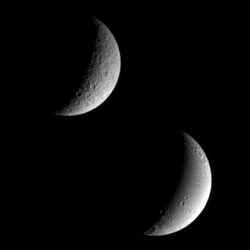
Saturn’s moons, Rhea and Dione. Image credit: NASA/JPL/SSI Click to enlarge
Saturn’s sibling moons, Rhea and Dione, pose for the Cassini spacecraft in this view.
Even at this distance, it is easy to see that Dione (below) appears to have been geologically active in the more recent past, compared to Rhea (above). Dione’s smoother surface and linear depressions mark a contrast with Rhea’s cratered terrain.
Sunlit terrain seen on Rhea (1,528 kilometers, or 949 miles across) is on the moon’s Saturn-facing hemisphere. Lit terrain on Dione (1,126 kilometers, or 700 miles across) is on that moon’s leading hemisphere. North is up.
The image was taken in visible light with the Cassini spacecraft narrow-angle camera on Nov. 1, 2005, at a distance of approximately 1.8 million kilometers (1.1 million miles) from Rhea and 1.2 million kilometers (800,000 miles) from Dione. The image scale is 11 kilometers (7 miles) per pixel on Rhea and 7 kilometers (4 miles) per pixel on Dione.
The Cassini-Huygens mission is a cooperative project of NASA, the European Space Agency and the Italian Space Agency. The Jet Propulsion Laboratory, a division of the California Institute of Technology in Pasadena, manages the mission for NASA’s Science Mission Directorate, Washington, D.C. The Cassini orbiter and its two onboard cameras were designed, developed and assembled at JPL. The imaging operations center is based at the Space Science Institute in Boulder, Colo.
For more information about the Cassini-Huygens mission visit http://saturn.jpl.nasa.gov . The Cassini imaging team homepage is at http://ciclops.org .
Original Source: NASA/JPL/SSI News Release
